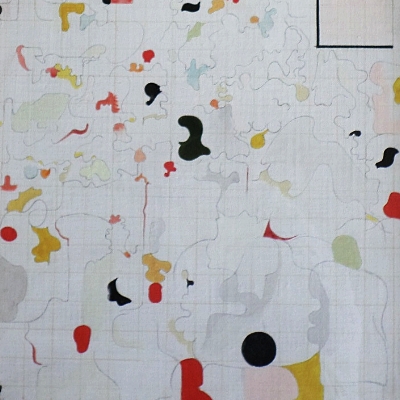Merlyn Evans wrote in the introduction to his exhibition at the Marlborough Gallery in March 1968 .....
' By temperament and preference, I have been from the early age of seventeen an abstract painter'
He was precociously gifted as a student at the Glasgow School of Art and then Royal College of Art in London and exhibited at the Royal Scottish Academy on 1930 and 31. He was influenced by Surrealism in the 1930's and also Mondrian . Evans temperament combined passion and philosophical speculation and argument, and he was well read in psychology, philosophy, politics and the history and techniques of art. He was also profoundly affected by Modernist literature and poetry, a lover of music and player of jazz piano and trumpet. He married the concert pianist Marjorie Few in 1950 I think it is interesting that his abstract work seems to have started in the late 1950's with a series of work entitled The Orchestra. These derived from studies made from the box at the Festival Hall and were an attempt to depict the ensemble of the orchestra as a crowd.
The theme of crowd and its complex form and process continued to fascinate Merlyn Evans and drove him to produce the vast Waterloo Station Series in 1963.
His final work consisted of four tall sections of nine feet by four but what we have here at Blondes Fine Art in Hertfordshire are two of the studies that he painted at the station over a period of years. These recorded, what he termed 'direct from nature'. The final work was too big to be hung in the gallery rooms of Tunnard and Roberts where Evans exhibited in October 1963, and was displayed instead in the studio, a disused church in Fleet Road, Hampstead, which was also large enough to house his huge presses. ( see image below of Evans in front of the huge panels )
Merlyn Evans had after returning from the war, learnt etching and aquatint and became a master intaglio printmaker and he is still considered to be one of the Modern British 'greats' in this particular field.
The sequence of panels in the Waterloo Series is also interesting as it suggests a musical process of complication to simplicity, with overlapping transitions from the figurative to the geometric. Panels one and three where described by Evans as 'figurative with a controlled degree of representation. Everything is on the move. ' In panel one the crowd is clearly seen as a collection of individuals, massing at rush hour into spaces between the booths and advertising hoardings. In panel three there is more of a merging into one mass. Panel two gives a cinematic shot of the stations static properties with the crowd in the foreground while the transition to abstraction is complete in the final panel which shows the station reduced to purely geometric forms. It seems that Evans wanted to articulate the disconcerting vision of the modern city of London with its human masses in contrast to the stark modern architecture.
The pair of works available here are for panels three and four and come from the personal collection of the great British composer Malcolm Arnold. His work is hard to find and rarely available other than in a few St James, London galleries so please do contact us to arrange a viewing or for more information about these works.


